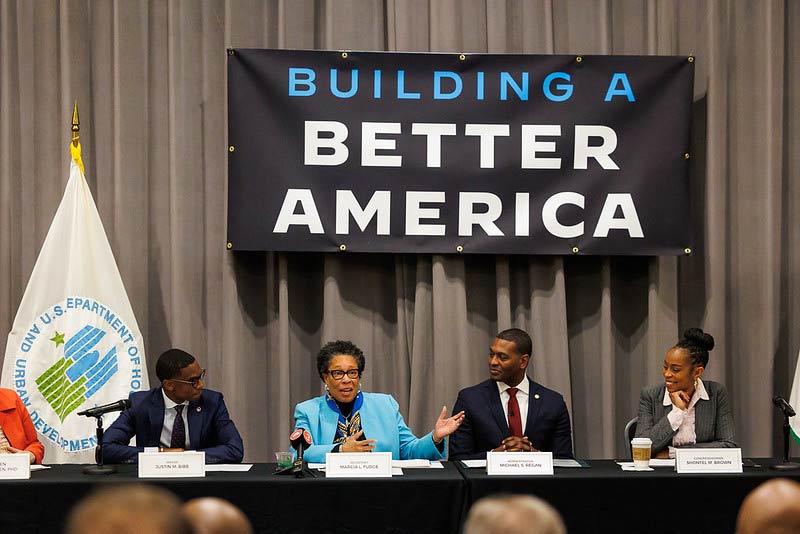Housing is Infrastructure
June 30, 2022

Infrastructure fundamentally exists to provide connections. Those connections, whether via the built environment or over the internet, almost always include one’s home as either the starting place or the destination. Given how central housing is to infrastructure, as well as the historic investments under President Biden’s Bipartisan Infrastructure Law (BIL), HUD is working with federal agencies and across levels of government to connect transformative investments in transportation, climate resilience, broadband, and water infrastructure with HUD’s investments in affordable, quality housing.
The Bipartisan Infrastructure Law was a once-in-a-generation investment in our nation’s infrastructure and competitiveness – an investment that is lowering costs for American families and strengthening communities.
The U.S. Department of Transportation (DOT) has already made several announcements for competitive grant programs totaling over $6 billion in BIL funding that reward jurisdictions that have put in place land-use policies to promote density and rural main street revitalization; DOT will continue this emphasis in other relevant discretionary programs. HUD received $5 million in technical assistance funds in the Fiscal Year 2022 budget that it will use to improve the coordination of housing and transportation planning to advance residents’ access to economic opportunity and increase housing supply. DOT received $25 million for a similar purpose, and the two agencies are working together to align the uses of these funds as part of a “Thriving Communities” initiative that was launched today. Deploying technical assistance in this way will enable more communities to thoughtfully plan and execute transformative infrastructure investments that better serve existing and planned affordable housing developments.
In addition to enabling affordable housing developments to benefit from BIL infrastructure investments, HUD is also working with relevant agencies to use funding from BIL to improve resilience and housing quality. Improving the quality and resilience of housing extends the lifespan of existing housing and lowers costs for families. HUD’s Office of Lead Hazard Control and Healthy Homes is partnering with the Department of Energy’s Weatherization Assistance Program (WAP), which receives BIL funding, to further develop HUD’s Healthy Homes and Weatherization Cooperation Demonstration grant program that will mitigate health and safety hazards in the WAP-enrolled homes of low-income families and will improve energy efficiency and comfort in their homes. HUD is also using its funds to build state-level expertise, by working with external stakeholders and state energy offices to direct states to multifamily weatherization training resources. The President’s FY23 budget request for HUD includes language that will better align the eligibility criteria for multifamily weatherization services from the Department of Energy with similar HUD programs.
The pandemic demonstrated the necessity of being able to work and learn from anywhere, including one’s home, and BIL provides money that will help low-income households and HUD-assisted tenants to gain reliable internet access. BIL included $65 billion to expand broadband in communities across the country, create more low-cost broadband service options, and subsidize the cost of service for low-income households. The largest program, the Broadband Equity, Access, and Deployment Program, enables states to competitively award subgrants to community anchor institutions, including public housing authorities. Most of that funding will go to states and territories to deploy high-speed broadband infrastructure in areas currently lacking access to such services, including HUD-assisted and low-income households. HUD also continues to partner with the Federal Communications Commission (FCC) to encourage sign-ups for the Affordable Connectivity Program, an FCC benefit program that provides discounts toward internet services and computer hardware for eligible households. Residents of HUD assisted housing are categorically eligible for this program. FCC's latest estimates suggest nearly 500,000 HUD assisted tenants are using the Affordable Connectivity Program so far, and HUD is working to increase the enrollment among its assisted tenants.
Finally, BIL enables HUD to make meaningful progress on our commitment to eliminate lead hazards in federally assisted housing, including tribal housing. The Environmental Protection Agency (EPA) received $15 billion in BIL funding to replace lead service lines, as well as additional funding to address contaminants in drinking water. HUD previously pledged to replace lead water service lines whenever water main feeder lines are being replaced and eliminating or mitigating lead-based paint hazards when rehabilitating assisted housing. HUD’s Office of Lead Hazard Control and Healthy Homes is coordinating with EPA to ensure these funding streams serve low-income households.
Housing is infrastructure, and HUD is committed to work across the federal government and with our state and local partners to equitably implement BIL. We encourage states and localities preparing to implement infrastructure investments to consider how to coordinate those investments with affordable housing planning – whether it be how new electric bus lines reach public housing sites or how funding to remove or address infrastructure barriers incorporates anti-displacement strategies for low-income residents and small businesses. We encourage our stakeholders and nonprofit and private partners to support the historic opportunities presented by the Biden-Harris Administration’s infrastructure funding through additional resources to transformative infrastructure projects, investments in grantees’ capacity building, utilization of local small businesses and workforce, and public-private partnerships that drive equitable community benefits.
Through the actions detailed above and potential future actions, HUD and our partners can improve access, reduce costs, and improve housing quality, health and economic opportunity for HUD-assisted households and HUD-invested communities.
Learn more about the Bipartisan Infrastructure Law’s resources at: www.whitehouse.gov/bipartisan-infrastructure-law
Aaron Shroyer and Sarah Brundage contributed to this blog post.